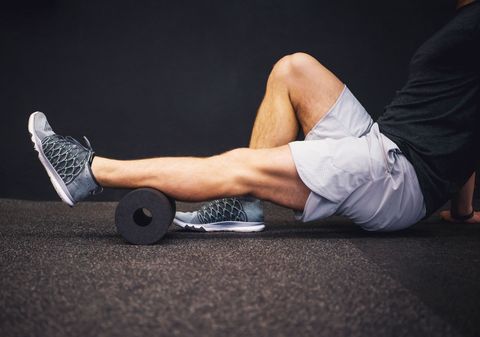For years, scientists researching pain, movement, and recovery had no interest in the weblike tissue known as fascia, which coats your muscles, nerves, and organs.
But things have changed. Researchers—and savvy trainers—now view something called fascia as your secret weapon both in and out of the gym. If you take care of it, your body will perform better while you’re working out and you’ll experience less pain overall. “Fascia is one of the most important and pervasive systems, because it connects every system together,” says Rebecca Pratt, Ph.D., a professor of anatomy at Oakland University.
If you’ve ever foam rolled, or if you use a Theragun, or if you’ve tried scraping therapy, then you’ve been treating your fascia, even if you didn’t realize it. But if you want to take that treatment to the next level and really eliminate muscle pain and soreness, then you need to know how your fascia works.
The Science of Fascia
To understand how this critical tissue works, imagine an orange. The peel is your skin. Directly beneath that peel is a white, gauzelike substance that surrounds each orange wedge and ensures that the orange maintains its spherical structure. That gauzelike substance is your fascia, a connective wrap made of gelatinesque glycoproteins that soak up water, collagen, and various other cells. Its main job: to hold your muscles, joints, tendons, and bones in place.
Fascia covers every muscle in your body, and when it tightens in the wrong places, it causes pain. You’ve felt this pain before, all those times you wrapped up a serious muscle sesh and could barely walk upstairs.
Much like a sport coat, the tissue surrounding your muscles can bunch, wrinkle, and stretch. And when it gets injured, it rebuilds as scar tissue, with fibers in a crisscrossing pattern. Fibers on healthy muscles and fascia all run in the same direction; when they crisscross, they bunch up even more and can pull and tug at joints.
Six Problems You Can Fix With Fascia

alvarezGetty Images
There’s a good chance you’ve experienced this before, too, and you may have solved it with the most common method of realigning these fibers: foam-rolling. Doing so properly helps loosen damaged areas, relaxing and smoothing them. Take your fascial care to the next level with these strategies.
Headaches
How Fascia’s Involved: Blame your desk job: That stabbing pain at your temples is often related to cranky neck fascia. When your head and shoulders shift forward instead of staying aligned with your spine, the muscles (and the fascia around them) at the base of your head tighten, while the ones that control your shoulders grow weak. Your pectoral fibers also tighten, pulling your shoulders further forward. The combo in this sensitive area leads to tension headaches.
Your Move: Strengthen your shoulder and back muscles and open your chest all at once with seated rows. Aim to do 3 sets of 12 at least 3 times a week.
A Lack of Athleticism

Sam EdwardsGetty Images
How Fascia’s Involved: Contrary to what your body tells you some days, your days as a terrific athlete may not be long gone. But some days, they certainly feel like they’re gone, mostly because you haven’t trained your fascia. Researchers recently discovered that fascial tissue stores more kinetic energy than any other type of tissue. In fact, the springiness of fascia (not powerfully muscled calves) is the driving force that allows kangaroos to make 30-foot leaps. Because of this relationship, experts think plyometrics training makes your fascia more durable and resilient by increasing its density.
Your Move: Forget fixing your fascia and actually strengthen it. Three times a week, spend up to 5 minutes doing agility ladder drills. Don’t have a ladder? Do 3 sets of 10 to 20 jump squats.
Chronic Foot Pain
How Fascia’s Involved: Plantar fasciitis, or heel pain due to inflamed fascia in the sole of your foot, strikes 2 million people each year, especially runners. It’s often due to calf tightness—or flat feet.
Your Move: Roll your feet over a lacrosse ball for a minute each, ideally every
day. In addition to that, foam-roll your calves for up to 5 minutes each.

Goolia Photography
Back pain
How Fascia’s Involved: Where your thoracic (middle) and lumbar (lower) spine meet is a nightmare zone. Restricted fascia anywhere—particularly in your hamstrings or quads—can pull on the fascia here. If you work a desk job, it likely means trouble in your psoas, a muscle in your hip flexors that lets you lift your knee and is vital to core strength.
Your Move: Because it’s located so deep in your pelvic region, releasing the psoas is challenging. Stretch your hip flexors (try pigeon pose), and foam-roll your hamstrings at least twice a week.
Trouble Moving After An Injury
How Fascia’s Involved: After surgery or a severe injury, your body forms collagen-based scar tissue that can replace healthy fascia. The problem: Normal tissue fibers line up parallel to one another. Scar tissue develops in a haphazard way, limiting your muscles’ ability to lengthen and contract.

alvarezGetty Images
Your Move: Once the damaged area has healed, begin gentle massage techniques, like gliding the skin forward and back, then side to side, for several minutes a few times a day, realigning fascial fibers.
Joint Stiffness
How Fascia’s Involved: Tightness in muscles and surrounding fascia can cause joints to stiffen, making your body move in ways that can create long-term issues. An example: Tight calves reduce your toes’ ability to flex toward your shin, changing your gait.
Your Move: Foam-roll or stretch any tense area right after each workout, since your muscles respond best when warm. Try to do three 30-second standing calf stretches (legs straight, heels down) daily.
Source: Read Full Article
